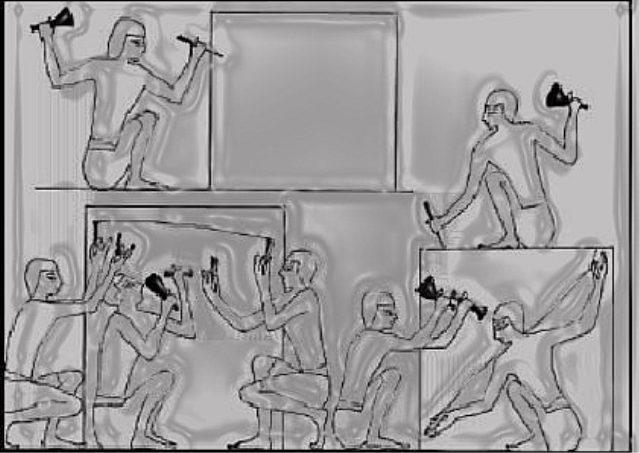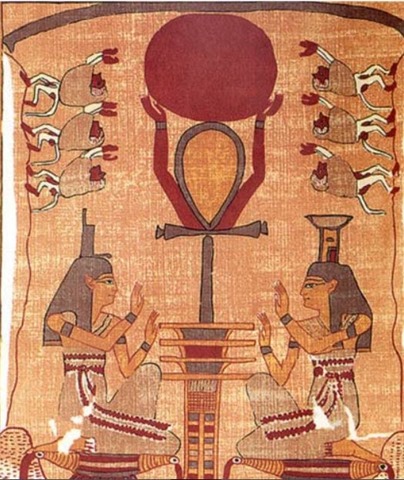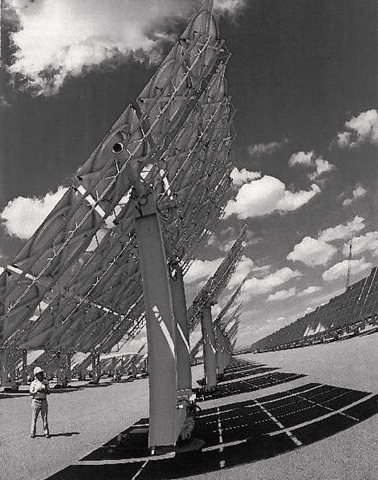A Greek by the name of Herodotus lived back four hundred and ninety years before the Christian era began and is considered by The Scholarly World to be “The Father of History.” In one of his many books that he wrote called HISTORY BOOK II page 124. Herodotus gives an account of the building of the pyramid that was related to him by some local Egyptian Priest.1
That is Twenty Years to cut and stack 2.3 million blocks2, (average weight five thousand pounds average thickness four feet), to stack to a height of almost four hundred and fifty feet: twelve hours per day, seven days a week. That is twenty-six blocks per hour, (with copper and wooden tools?) now double that amazing feat because there was the Second (red) Pyramid next to the Great pyramid that was only two and one-half feet shorter and was built at the same time as the Great Pyramid. Even so, those structures construction was far easier than what you have been expected to believe. The Egyptian used simple engineering techniques to do their amazing feats. Techniques that are surprisingly still used today, concepts that have never been lost; nonetheless, those techniques have never been applied to the building of the Pyramids, by the Discovery or, History Channel, and certainly not by Wikipedia.
To interpret the riddle of the construction techniques, you must understand the basic laws of physical science, which includes the tools’ of Archimedes. However, these techniques were Egyptian “TOP SECRETS” so they were locked in a safe place hidden from their “Enemies” and from the “Common Folk” in Riddles. Making sure that the ignorant saw only what the Egyptians wanted them to see Fairy Tales. The process of quarrying the stone for the Pyramids has been as BIG a mystery as the Pyramid itself. How could a Copper Age society use its copper tools to cut and finish rocks some of which were harder that the copper tools themselves? This baffled the Scholarly World for hundreds of years and was “hard to explain” (a crux, riddle). The answer should have been in plain sight. And it was “with a handle” (ansala), because, the Egyptians used cruxansalas and sunshine to quarry the stone.
To understand this riddle, we will need to go back to my Great-Grand-Parent’s time. Many of those folks were poor. There were times that they needed just one more drinking glass. As it happens, my folks had no money to buy an extra drinking glass and sitting down to supper with an old beer bottle when the visiting pastor came by was a little tacky. So what is a poor woman to do? Have Grandpa make a glass. Forget your visions of a blast furnace and a pipe with a glob of glass on the end. No. What the Old Man did was, take that beer bottle and put a kerosene-soaked sting around the bottle and then tie the kerosene string tight. He would then light the string on fire all the way around. Then he would stand the bottle up straight then in a few seconds he would hear a PING. Then Grandpa would blow out the string. The bottle now separated in two pieces. The top makes a handy dandy new funnel and the bottom is Grandma’s new drinking glass. Now why did that happen? The heat from the flames heated the top and the neck of the beer bottle. Below the flame stayed cool when the differential in temperature was high enough between the top (from the flame and above) and the cool bottom (below the flame) a fracture would start and run around at the point of the temperature differential separating the glass bottle into two pieces.
Now let us go back to my child hood and when I was in the Cub Scouts, and one of those many Christmas presents that children would make. Some of those projects would have pretty colored clear glass marbles that looked nice just by themselves. Nevertheless, my Den Mother said, “West, it is your job to add some value to those marbles.” The scout leader heated these round pieces of glass in the oven as hot as that oven would go. Then the leader pulled the clear colored marbles out, and each child drops his marbles carefully into a glass of water SNAP, CRACKLE, and sometimes POP. Now those marbles have pretty hair line fractures and are very fragile if you drop one of those fractured marbles it would break into a thousand pieces, all mine did!
Those two little experiments are the foundation for cutting the stone for the Great Pyramids, surfacing the site and tunneling the passage for the Bottomless Pit. Because, there is sufficient evidence that Ancient man used heat or fire and water to break stone in his mining operations of the past.3 Even so, there was a lack of precision, (though the process was a lot easier than mushrooming your copper tools) in fact that is how the Caliph Al Mamaun broke through the stones of the Great Pyramid to gain access to the interior.
The Caliph Al Mamaun broke into that structure by placing wood and brush against the stones of the Great Pyramid then setting the wood on fire. The fires heated the stone just like my Den Mother’s oven heated the marbles. Next at the right time the Caliph’s minions threw water and vinegar against the stone fracturing the stone into pieces that were easy to dislodge, (the vinegar help fizz the limestone pieces loose). The Caliph was the first man in centuries to enter The Great Pyramid of Gizeh back in the year 840 of the Christian era. The problem was that the Caliph and his minions chipped a hole into the side of the Pyramid at the wrong place. He was 286.1 inches off from the easy Sinister (left) entrance below.5 Instead, The Caliph broke through at the spot he chose, leaving a large hole in the wrong place. This system of breaking rock with fire and water is fine for a slow mining operation. However, wood has never been that abundant in Egypt and when you have millions of precision stones to cut the process would be impossible to do in the allotted time of twenty years.
The Egyptians used Mercury and Golden Mirrors to do their Magic. However we must first go back to Syracuse, Sicily to the year 209 before the Christian era and look at one of the many innovations of our old friend Archimedes. King Hiero had Problems; ships of the Roman Navy, which were full of troops, were on their way to besiege his kingdom. So king Heiro called for his most trusted scientist, Archimedes.
When asked for his advice our little old friend probably said, “Don’t worry our harbor faces south, and when I was in Alexandra Egypt I learned of Aten and his Magic Mirrors. Those mirrors were used to create the heat of the sun (a heilostat). We can just make a bunch of those round, mirrored, and burn the Roman Armies eye balls out.”
And those mirrors did just that. Now let us apply that knowledge to our riddle of the stone quarry.
The process goes all the way back to Enoch Chapter 8 and the Watcher Azazyel.7
“Who taught men… the fabrication of mirrors… and the uses of stone of every valuable and select kind.8”
However, if the Egyptians use sunshine and mercury mirrors to quarry those stones: where is the Historical evidence? All over Egypt on its temple walls, its papyrus’s, its jewelry and especially Karnakh: Sadly, the process has been misinterpreted for centuries. Let us go back to the Hittite Sun disk; that is the basic design: a mirror in the center of two wings for precision targeting and a tail to sit on the ground to allow vertical alignment. In its simplest form, elongate the tail; move the wings down and the mirror up and what have you got? The Ankh also known as the cruxansalas, the riddle with a handle, Amenophis IV also known as Akhenaten showed Aten as a solar orb, a sun-globe with rays which end in tiny human hands holding an Ankh, this tool was the genesis for Archimedes’ mirror defense of Syracuse.
To the Ancient Egyptians the Ankh was a symbol and a tool of power.9 The loop of the cruxansalas is where the mirror went. A funny thing about mirrors they can seem transparent at times giving the illusion that you can see right through them. Therefore, the Egyptians left out the mirrors in many ceremonial Ankhs to give that effect.
However, there are also many pictures of Ankh with golden mirrors in the loop and as you know gold is the best reflector of sunshine. You also know that you can redirect the light and heat from the sun to another location with a mirror. Now if you take a second mirror and redirect its reflection of the sun to the same point you double that heat and light. If you keep doing that with more mirrors you can produce some real heat you can use the power of the sun that is easy to harness with a few magic mirrors. A form of energy that is fresh and clean with no cost of production, a power to the common folk as magical as Alchemy. In fact Barstow, California has a solar furnace system that can produce ten megawatts of electric power out of thin air using one thousand nine-hundred mirrors. The system uses Steam electric turbines’ not solar electric cells to produce the power.
Now that we have the Ankh with a mirror on the top and a central shaft to rest on the ground, This shaft also stabilizes its movements for long periods, which allows that mirror to be tilted to catch the sun and its vertical movement. The cross handles or wings of the cruxansalas allow for horizontal precision targeting over shorter distances. Now put a few thousand men of your 100,000 men to targeting a mirrored Ankh, now you have some real heat. To reduce the area needed for all those men and give a higher concentration of light: make some of the Ankhs taller and some shorter, and have the men stair-step them: and this enables you to concentrate the heat on a smaller target when needed. An example would be the tunneling of the Bottomless Pit, because this process is lot cleaner that a brush fire.
Yes, the Ankh was thought to be a symbol of great power and the cruxansalas of Aten were, nevertheless, what will people think of our “computer and mouse” of today in 10,000 years?
The limestone of Egypt was important in the quarrying process, because of its sedimentary origins; Limestone is a stratified rock, with individual layers ranging from the thickness from laminate to beds measuring several feet from top to bottom. Granite in the Aswan area of Egypt occurs in dikes and sheets which magma has injected between layers of older rock: A type of magma emplacement known as lit by lit (bed-by-bed) injection, forming two flat surfaces, tops and bottoms, and, many times forming large square crystals.
The most common stone in the Great Pyramid is limestone, though Granite is cut in a similar manner, when the large crystals had not been pre-shaped by GOD were used. The limestone is stratified rock from thin layers to several feet thick. These layers have a consistent thickness for hundreds of feet to miles and are as flat as a calm mountain pond at dawn. That gives the quarry men two perfectly flat working surfaces to work with that need no detail work to be used in the pyramid.
However, to accomplish this quarrying of stone, we must first call in the string pullers or the chalk linemen to lay out the stone: and then the spaldings would chisel the line that the string pullers had laid out, the line would go between two natural fault lines in the stone. As the spaldings worked, the quarry men would remove the under burden back parallel to the line that the spaldings had chiseled out on the top of the stone. The nice thing about fresh limestone rather than cured limestone is that it is softer: the longer that it is out of the ground the harder the limestone gets (to a point)3. The quarry men used a similar process as the Caliph did, but Egyptians used the Ankh, solar furnaces system of Aten of Karnack as the heat source to superheat the stone.
They would then throw the water and vinegar against the stone: no need to play in wet ashes, like the Caliph’s minions did. After the fractured rock had cooled, a copper headed battering ram that was suspended by an A-frame was used to break loose the fractured rock. Nevertheless, as soon as possible, wooden supports would quickly be installed to stabilize the upper layer of rock. The different strata of rock would buffer the heat and allow for a smooth transition between layers of rock. The scrap rock was important too, but more on that later in this book.
When the under burden was removed to the point of the chiseled groove, the whole section of rock that was cantilevered would be blackened with charcoal and behind the line the stone was covered with wet sand. The blackened stone was then heated with the sun and the hundreds of Ankhs mirrors. Under the stone a thick layer of sand was placed for the stone to land and a fire to help heat the stone from the bottom. Moreover, at just at the right time, the supports were pulled, and wedges were driven down at various places. Because of the weight of the stone and the heat differential of the rock, the long slab would snap. Crackle. BOOM!
On the bed of sand, if the slab was at least the second cut, now lies a long slab of stone with two smooth perfect and flat sides. The other two sides will lock into the slabs that had been cut just before and just after as if they were one: because they were one once, and every piece fitted together like a jigsaw puzzle: because they are all the same thickness, each layer stays flat without deviation. Now that, the long slab of rock weighing hundreds of tons is lying on a thick bed of sand and rubble.
What next? Lay out the cuts to offset the last row of blocs that had been cut. Next, undermine the slabs at the point the stone has been scored and place a fulcrum, and then remove the sand to the fulcrum. The Quarry-men placed log rollers under as they remove the sand. And by, positioning a support under the black end block, the quarry-men then would put wet sand on top of the rest. By this means heating of the stones with the Ankh, solar furnace system and a fire below the stone; when they pulled supports at the right time, wedges were driven down at various places and snap, crackle, BOOM. You now have a block ready for the pyramid. The next block will fit together as if they were one because they were one once. Then the stone was sent down the hill on the log rollers to the river. Yes the quarrying was done with soft metal tools more quickly than with modern high tech equipment .















